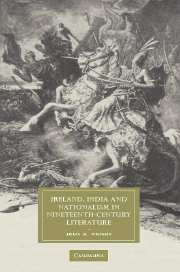Book contents
- Frontmatter
- Contents
- Acknowledgments
- Introduction: Insensible Empire
- PART I National Feeling, Colonial Mimicry, and Sympathetic Resolutions
- PART II Colonial Gothic and the Circulation of Wealth
- 4 On the frontier: sensibility and colonial wealth in Edgeworth and Lewis
- 5 “Some Neglected Children”: thwarted genealogies in colonial history
- 6 Bram Stoker and Oscar Wilde: all points east
- Conclusion: The Wild Irish Boy in India
- Notes
- Bibliography
- Index
- CAMBRIDGE STUDIES IN NINETEENTH-CENTURY LITERATURE AND CULTURE
6 - Bram Stoker and Oscar Wilde: all points east
Published online by Cambridge University Press: 31 July 2009
- Frontmatter
- Contents
- Acknowledgments
- Introduction: Insensible Empire
- PART I National Feeling, Colonial Mimicry, and Sympathetic Resolutions
- PART II Colonial Gothic and the Circulation of Wealth
- 4 On the frontier: sensibility and colonial wealth in Edgeworth and Lewis
- 5 “Some Neglected Children”: thwarted genealogies in colonial history
- 6 Bram Stoker and Oscar Wilde: all points east
- Conclusion: The Wild Irish Boy in India
- Notes
- Bibliography
- Index
- CAMBRIDGE STUDIES IN NINETEENTH-CENTURY LITERATURE AND CULTURE
Summary
“I want to know why you didn't obey me ordhers?” sez the Saint. …
“I didn't obey,” sez he [the King of the Snakes], “because I thraverse the jurisdiction.”
“How do ye mane?” asks St. Pathrick.
“Because,” sez he, “this is my own houldin',” sez he, “be perscriptive right,” sez he. “I'm the whole govermint here, and I put a nexeat on meself not to lave widout me own permission,” and he ducks down agin into the pond. …
So the Saint stood on the edge of the empty lake an' held up his crozier, and called on the Shnake to come forth. And when he luked down, lo! an' behold ye! there lay the King iv the Shnakes. … Then the Shnake raised his head, and, lo! and behold ye! there was no crown on to it. …
“An' till ye git me crown I'm king here still, though ye banish me. An' mayhap, I'll come in some forrum what ye don't suspect, for I must watch me crown. An' now I go away – iv me own accorrd.”
Bram Stoker, The Snake's Pass (1890)In Wilde's The Picture of Dorian Gray (1891) and Stoker's post-Dracula fiction, most notably The Lady of the Shroud (1909) and The Lair of the White Worm (1911), the gothic not only serves as a means of articulating the “dawn of simulation,” as Hogle has compellingly argued in relation to Dracula, but also as a vehicle by which Stoker and Wilde co-opt the globalism of modernity to reveal the emptiness of collection and revalue the hybrid subject of colonialism.
- Type
- Chapter
- Information
- Ireland, India and Nationalism in Nineteenth-Century Literature , pp. 182 - 210Publisher: Cambridge University PressPrint publication year: 2007



